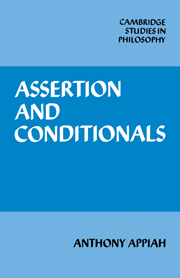6 - Realism and truth-theory
Published online by Cambridge University Press: 07 October 2011
Summary
To know the meaning of s is to know under what conditions s would count as true.
(Wiggins, 1971)OVERVIEW
I turn now from an account of certain general features of the mind to an account of declarative meaning. In doing so I begin by examining the main stream of thought about meaning; what I believe to be the central theory in philosophical semantics. I mean what Michael Dummett, amongst others, has called ‘realism’.
Realism, in semantics, as I characterise it, is the claim that the meaning of a central class of declarative sentences can be given by stating their truth conditions. This way of putting the matter leaves much open. Which class of sentences is central? Do we give meanings to token sentences or to types? And, above all, what, for sentences, are truth conditions? Without answers to these questions realism is just a scheme for a theory of meaning; a scheme we might acquiesce in without being clear what it entailed. The service Donald Davidson has done us is to offer a way of filling out the scheme; a way that allows us to ask and to answer these and many other questions. But it is just one way. And if we end by rejecting it, that is not the end of realism. Some other way of filling out the scheme might do the job.
Information
- Type
- Chapter
- Information
- Assertion and Conditionals , pp. 123 - 142Publisher: Cambridge University PressPrint publication year: 1985
